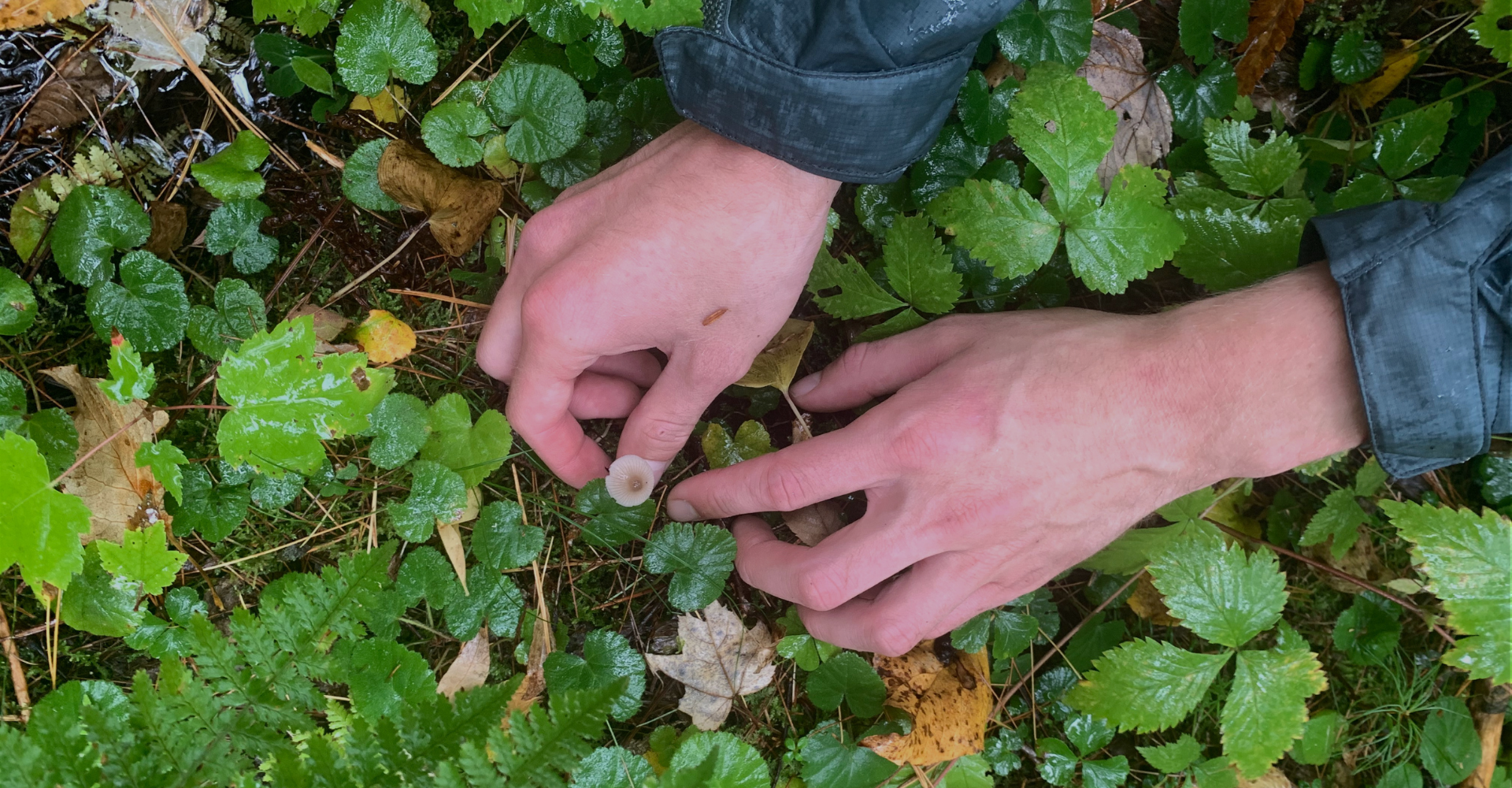

I stood ankle-deep in mushy, mossy mud. My car sat parked a hundred yards away on Lyon Road, which runs straight through Nelson Swamp, an unassuming forested area in Cazenovia, New York, about 22 miles from my house in Syracuse. Basket in hand, I searched for mushrooms nestled by ferns, wedged between rotting logs, and under blankets of decomposing fall leaves on my second foraging outing.
After a mind-numbing few days of shelter-in-place orders last March, I first headed outside and picked the few mushrooms I saw peeking out of the grass in my front yard. But they sat on my front porch post-pick for days, rotting as I tried to identify if they were edible. This time, though, there would hopefully be no debate about whether I could eat what I picked. I brought along a seasoned forager, Ben VanderStouw, or rather, he brought me along. Looking at his hiking boots, Patagonia rain jacket, and rain pants — “Yes, I’m a nerd who has rain pants, what can I say?” he jokes while stepping into them when we arrived — I knew this guy had eaten his fair share of foraged mushrooms. Though his mask covered most of his face, I caught glimpses of the blonde mustache that matched his light, bushy eyebrows and hair that seemed forever pressed down by a hat or helmet.
A graduate from State University of New York Environmental Science and Forestry, VanderStouw has used the Covid-19-induced isolation and the pause it placed on a job in Idaho identifying plants and soils to instead explore the outdoors and forage. Given his time in classes about all things moss and fungi, the considerable amount of times he’s eaten things he’s foraged and survived, and the two mushroom identification books in his pocket, he’s an expert to me. He first became interested in foraging during his time at SUNY-ESF — where most of his classes involved one -ology or other involving plants — but has since gone out on foraging walks on his own to improve his ability to find and identify edible plants and mushrooms. We wandered the swamp, dodging branches and navigating over hummocks and hollows in a soft drizzle. With his knife and handheld magnifying glass for identifying mushrooms, VanderStouw marched among trees bearing their greens, yellows, reds, and oranges. I followed.
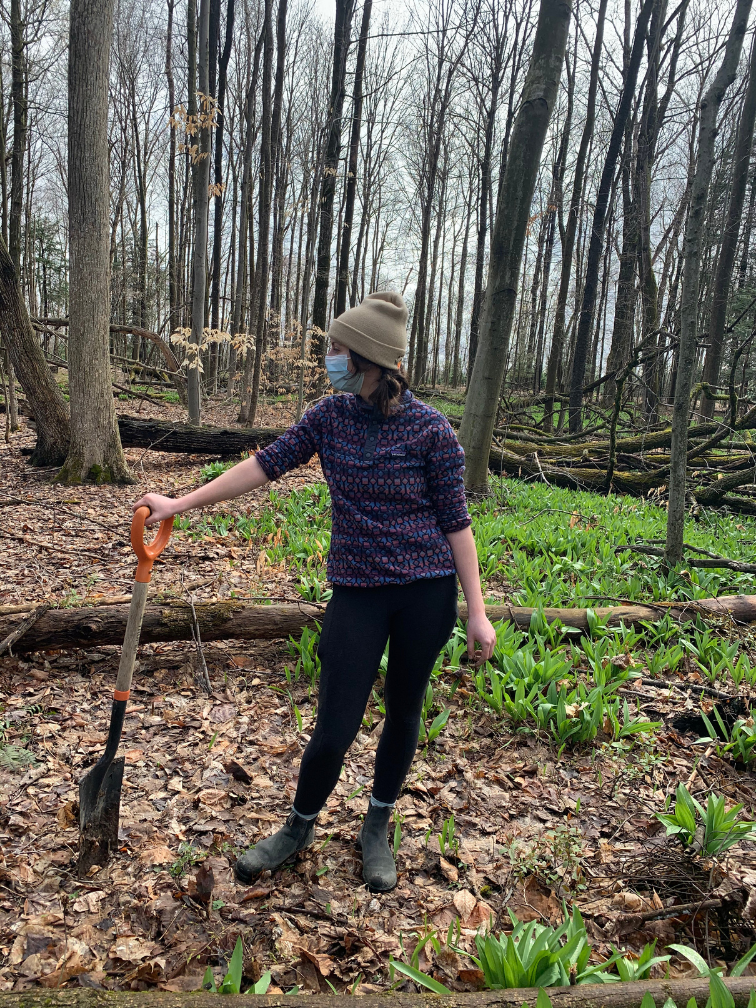
Yasmine Chahine, a senior at Syracuse University, takes a break from shoveling up ramps while volunteering with the Syracuse Urban Food Forest Project. Photo by Vivian Whitney.
He prefaced our journey with a lighthearted warning: “Hopefully some stuff will be out. If not, well, that’s why it’s mushroom hunting and not finding.” We did find mushrooms — soft, orange, funnel-shaped chanterelles no bigger than my pinky finger and a few stringy, capped mushrooms VanderStouw failed to identify with his mushroom guide due to the rain. VanderStouw placed the chanterelles in my basket, even though he spotted them, and he described how I should cook them (in a pan with butter and a pinch of salt). Even though mushrooms remained our top priority, VanderStouw pointed out other edible plants he recognized — the Indian cucumber-root, which he told me can be chewed to treat toothaches, and the bright orange gelatinous fungi bubbling over a tree trunk called witch’s snot, which he told me he thought was edible but couldn’t remember for sure.
Many share the instinctual intrigue and pleasure in searching for, finding, or even growing tasty and useful plants. And the pandemic provided a clarion call for those people to remove themselves from the couch, get out of their pandemic funks, and go outdoors. Google searches for “foraging” reached an all-time high in April 2020 as people found their way to foraging websites, books, and gardening advice, which all saw an increase in traffic and sales. An influx of visitors on ForagersHarvest.com surprised award-winning book author and forager Samuel Thayer and his wife Melissa Price, who own and operate the website. It features resources and information on foraging, offers foraging class sign-ups, and hosts the couple’s online foraging store where visitors can buy Thayer’s books as well as foraged and prepared goods sold in the couple’s physical store in Bruce, Wisconsin.
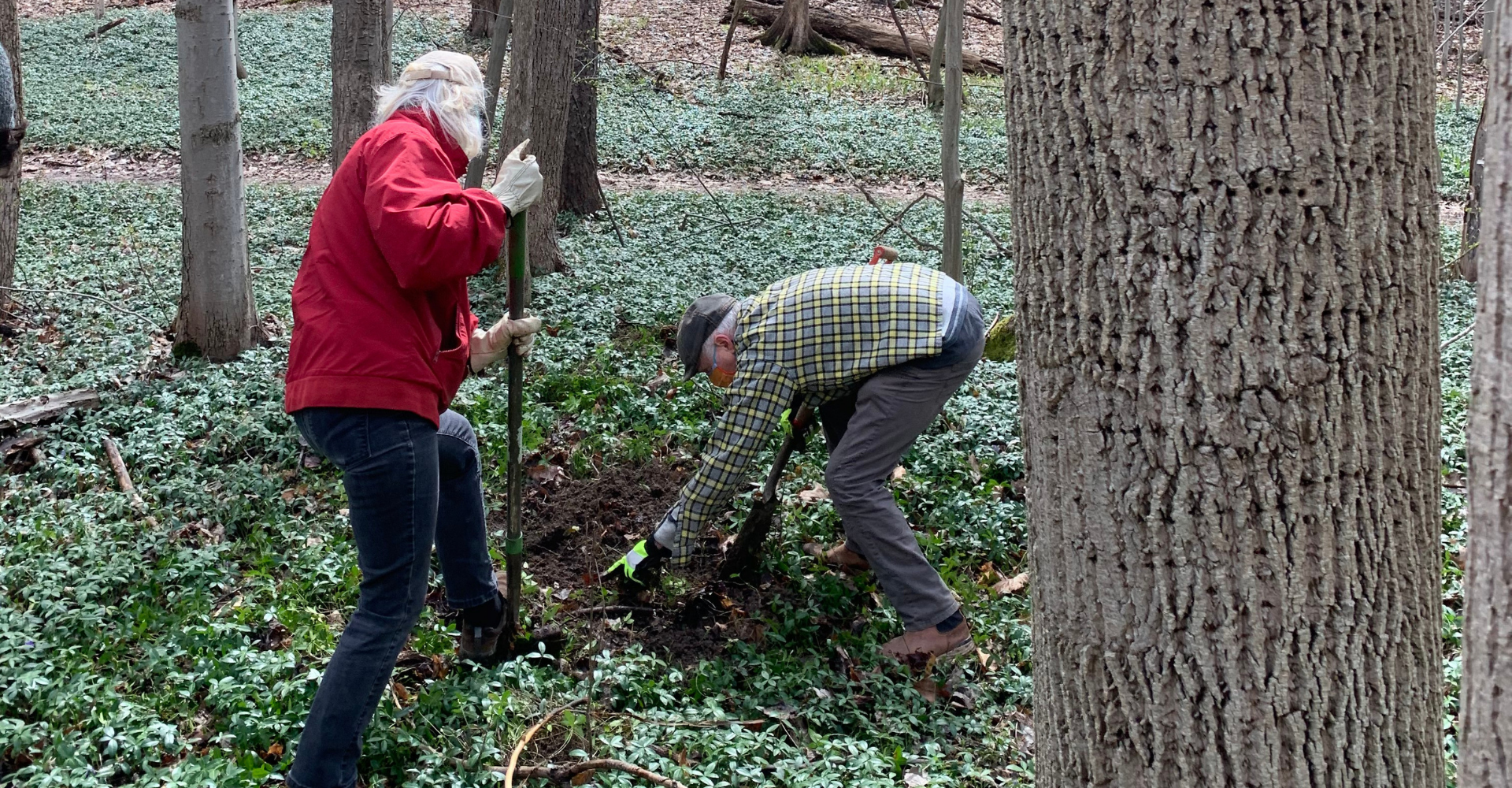
Anne Bellows and Matthew Potteiger work together to clear a designated area of periwinkle. Periwinkle grows aggressively and roots wherever the stem touches the ground, so it takes a bit of work to clear an area completely. Photo by Vivian Whitney.
“We certainly saw an increase in traffic, sales of our three foraging books, general interest in foraging classes, and online sales through our website,” Price says. Overall sales in their online stores increased six- to 10-fold in late March and early April and were up four-fold in the following six months, he says. Thousands of people took interest in Thayer’s books, such as The Forager’s Harvest and Nature’s Garden. In fact, sales for those books increased 14-fold in late March. “I sold more copies in a three-week period than I had sold in the entire previous year,” he says.
Rather than seeking out books and information on my own, I found foraging on TikTok — as did millions of others. Cradling the sunny-yellow head of a dandelion from her neighborhood, Alexis Nikole explains to her 414,000 TikTok followers at the time — now over 1.2 million — how to batter and fry the plant many consider a weed and a blight to eliminate from their yards. In a different video, she introduces wild violet and the ability to turn it into a color-changing syrup. She published her first video about foraging in early April 2020. “A little afraid of going to the grocery store?” Nikole asks at the beginning of shelter-in-place orders. “That’s O.K. I’m gonna show you some things that are growing in your neighborhood that you can eat.” Previously averaging a couple thousand views per TikTok, this video has earned more than 95,000 views, and her more recent foraging videos, showing how to eat acorns or make panna cotta with seaweed, have garnered up to 5.8 million.
While website traffic and TikTok views certainly point to an increased interest in foraging, “whether this has actually translated into more foraging is harder to know,” Price says. Foraging remains a challenging pursuit to measure, but other pandemic-fueled food hobbies such as gardening offer easier ways to measure their popularity thanks to tangible items like seeds. High Mowing Organic Seeds in Wolcott, Vermont gained 18,000 new customers during spring shelter-in-place orders. So True Seeds in Asheville, North Carolina enjoyed a threefold increase in sales volume — with 50% attributed to new customers. And the orders at Fedco Seeds in Clinton, Maine increased $13,500 in value last spring. “This is parallel to the increase in foraging,” says Tony VanWinkle, a professor of sustainable food systems at Sterling College in Craftsbury, Vermont. In fact, he calls this “the Covid seed rush.”
But reasons beyond loneliness and extra time fuel many people’s interest in gardening and foraging. In fact, interest in foraging continues to sustain enthusiasts into the winter for other reasons — such as food insecurity or acts of resistance. “Whenever there’s economic downturns or even areas of conflict or strife, there’s a spike in wildcrafting, wild foraging,” says Laura Beebe, an ethnobotanist and professor in the environmental humanities department at Sterling College. Beebe mentioned that many of her students last spring and summer talked about foraging to supplement their food during the pandemic (though it’s probably a tad bit easier for an ethnobotany college student in rural Vermont to do this than college students in urban areas studying something unrelated).
“If a young person eats from the environment, they’re connected with that environment for a very long time. It’s like it creates an environmental ethic.”
Tusha Yakovleva, a graduate student at SUNY-ESF who currently lives in Crestone, Colorado in the Ute homelands of the San Luis Valley, shared her foraging knowledge in 2020 by offering free online programs and informal foraging walks. In Russia, where Yakovleva grew up, foraging serves as a common family pastime that gave her the experience she needed to begin offering foraging walks to friends and friends of friends and information to anyone interested. She also self-published a guide book, Edible Weeds on Farms: Northeast Farmer’s Guide to Self-Growing Vegetables, in March 2020. Since the pandemic hit, she’s received many responses about the book’s timeliness and what a helpful resource it became during Covid-19, a time when many of her friends have expressed worries about the industrial food system. “I think we’re also sort of moving the needle from foraging being this esoteric, unknown thing to being more of how it’s seen in Russia, just a normalized part of subsistence and being human,” she says.
While some may begin foraging in response to worries about our food system, the problems causing these worries aren’t new, Yakovleva points out — problems such as unsustainability of the industrialized food system, monopolies on seeds, land depletion, and GMO concerns. “More people are forced into awareness of those issues,” she says, “because those issues are touching them and their families in a more powerful way than they have in the past.”
For many Indigenous communities, foraging has existed as a cultural and spiritual part of life for generations upon generations, helping to prevent the very problems that plague our food system today. Indigenous communities serve as a wealth of ecological knowledge and ethical sustainability in how they forage. “We always give thanks. We have our opening address, and it’s always about thanks,” Neal Powless, a member of the Onondaga Eel Clan in Syracuse, New York, says. Powless’ face, even through a computer screen, is soft and pensive as he moves through each story with measured thought, wearing a light blue button-down with his black hair pulled back into a loose ponytail. “You drop tobacco, you give thanks for the plants, and you leave that patch of plants. And then you walk to the next, and that’s what you gather, or the next. You never pick everything. You always leave something there.”
Powless enjoys sharing stories about foraging. It’s a critical part of his everyday life. If his wife spots a patch of ramps on a drive, they pull over — just like his mother and father used to do when he was a kid. If he’s running outside, he’ll stop to explore the woods and harvest wild onions after seeing a few on his path. But no matter where or what he’s foraging in each story, he mentions sustainability. “There’s this running joke among all of us,” he says about his clan and wild onions. “Someone will say, ‘Oh my gosh, you got wild onions. Where’d you go?’ We’ll just say, ‘I’m not telling you my spot. That’s my spot. Good luck. Find your own,” he says with a laugh.
But sustainability isn’t just about preserving a patch of wild onions out of respect for the Earth. For Powless, it’s also about preserving familial traditions and pleasure, things that also need to be sustained. For example, Powless’ youngest son loves wild onion soup. Powless wants to preserve those patches of wild onions so that he can continue to make his son’s favorite soup. “That’s what sustainability is. It’s about sustaining our energy and sustaining our good thoughts, our good feelings, our good experiences,” he says. “Those good feelings that come from food really sustain us.”
Ethical foraging, though, does more than add chanterelles to an evening meal or preserve wild onions for a son’s favorite soup. Foraging can be built into ecosystems — as it has been in Indigenous communities for centuries — to address problems within our current food system, such as food insecurity and the environmental consequences of industrial agriculture; and to work toward a more sustainable and equitable food system. In fact, those goals led me to volunteer to transplant ramps more than 20 miles from their home to an inner-city park in the Southside neighborhood of Syracuse.
Just months after leisurely plucking mushrooms from a swamp, I returned with my roommate Yasmine Chahine to Cazenovia — only a few miles from where I first ventured out to forage for myself — to help dig up ramps to plant in Elmwood Park as part of the Syracuse Urban Food Forest Project (SUFFP), an interdisciplinary research initiative between Syracuse University and SUNY-ESF. Stewart Diemont, a leader of the project and an associate professor of environmental and forest biology at SUNY-ESF, hopes creating food forests in Syracuse will offer food to the public at no cost, similar to a community garden. Food forests, though, mimic the natural ecosystem while allowing for urban foraging to supplement food access.
Ramps, a species of wild allium, serve as a foragable alternative to what we know as everyday produce, such as leeks, green onions, garlic, and chives. But despite their proximity (and, well, being endangered due to overharvesting), most opt for the convenience of a grocery store full of familiar fruits and vegetables. Currently, around 75% of the world’s food is provided by a mere 12 plant species and five animal species due to the developments of industrial agriculture, according to the United Nations Food and Agricultural Organization.
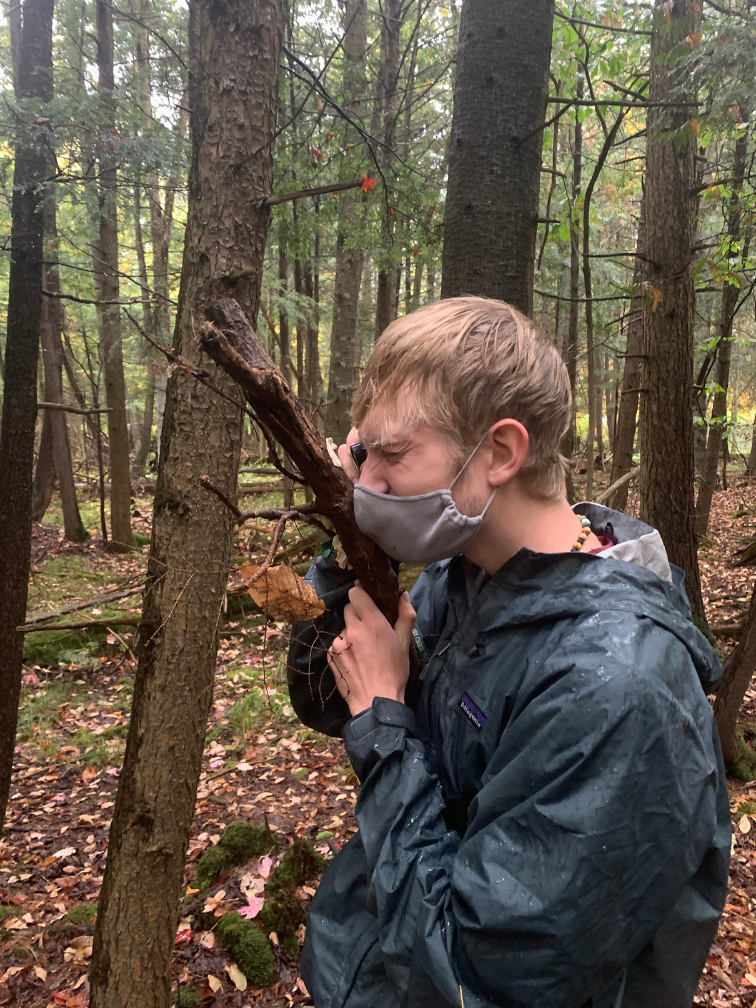
Ben VanderStouw studies a fungus through his portable magnifying lens to try and identify it. If he isn’t able to confidently identify a plant or fungus, he doesn’t keep it to eat. Photo by Vivian Whitney.
Agroecological solutions to industrial agriculture such as food forests, modeled after traditional agroforestry systems, offer natural, managed systems that help support biodiversity and provide a variety of plant species to eat, which helps create more resilient plant species and food sources. “How do we manage our ecosystems and think about them differently, so they’re not just production systems?” Diemont says. “What if we switch that to a form of reciprocal restoration where we’re giving back to nature?”
Diemont posed that question to me through the computer screen in November. By April, I decided to give back to nature with him side by side, digging up invasive periwinkle and helping restore the endangered ramp population. This work also served to help establish an urban food forest. Before the transplanting began at Critz Farms, a family-owned business that cultivates seasonal Upstate New York staples in Cazenovia, New York, I met the other project leaders: Matthew Potteiger, a landscape design professor at SUNY-ESF, and Anne Bellows, a food studies professor at SU. After introductions, we drove down a muddy dirt road that led to a forested area covered in patches of bright green ramps dotting the woody, leaf-covered hillocks.
Equipped with shovels, spades, recycled containers, bags, and boxes, we dug up a small clump of ramps from each patch, large and small, roots and all, to drive back to Syracuse. With Powless’ words and the future of the ramp population in mind, we took care to leave the area looking as untouched as possible save for a few piles of overturned dirt. Then, with the ramps in tow, Potteiger led us to meet Diemont at Elmwood Park. We worked in small groups, Chahine and I side by side, to shovel up the crawling periwinkle — Potteiger’s white hair peeking out of a worn gray flat cap and Diemont’s short black curls floating freely in every direction, both in dirt-stained pants, work boots, and bright green gardening gloves — and nestle the ramps safely into the soil in a crook in the forest, where they can establish, repopulate, and feed those who find them.
Many food forests that exist in the United States, Diemont points out, look more like a park or grove rather than a natural forest, which he wants to avoid with Syracuse’s food forests. “The idea is that you're not planting a grove, you're not planting just row crops here, you're planting an ecosystem,” he says. “You're tending to that ecosystem, tending a complex ecosystem that you are a part of.” Ramps, a creature of their ecosystem, love dead, fallen leaves. So we piled collected leaves around each transplanted patch to help nurture the natural ecosystem.
But a food system that includes foraging requires a different relationship with nature. “A food system can offer many types of ecosystem services and many types of ecosystem functions,” Diemont says. Besides simply provisioning food, for example, the activity of foraging connects us with nature, which can offer health benefits, education, spiritual renewal, and community building, Diemont says. Because of this, we have to think that rather than nature serving us, it’s giving to us, and to receive what it gives us — we must give back. And as far as being covered in mud, digging up periwinkle and planting ramps goes, I can attest to those ecosystem services.
That idea fuels the food forests Diemont hopes to establish. They’re environmentally sustainable but also sustain us and our community in the way Powless’ wild onion soup does by enhancing other areas of life. Diemont told me about a woman in Syracuse who runs a natural beauty shop and purchases burdock root as an ingredient for many of her products. Burdock root grows locally in Syracuse, and the SUFFP is working with her to make burdock root available in their food forests.
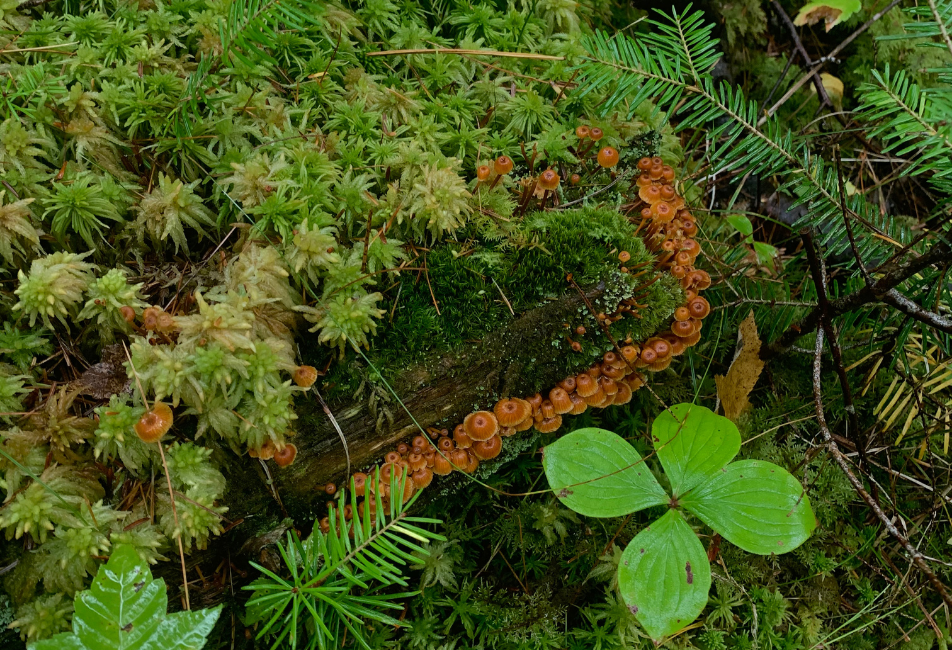
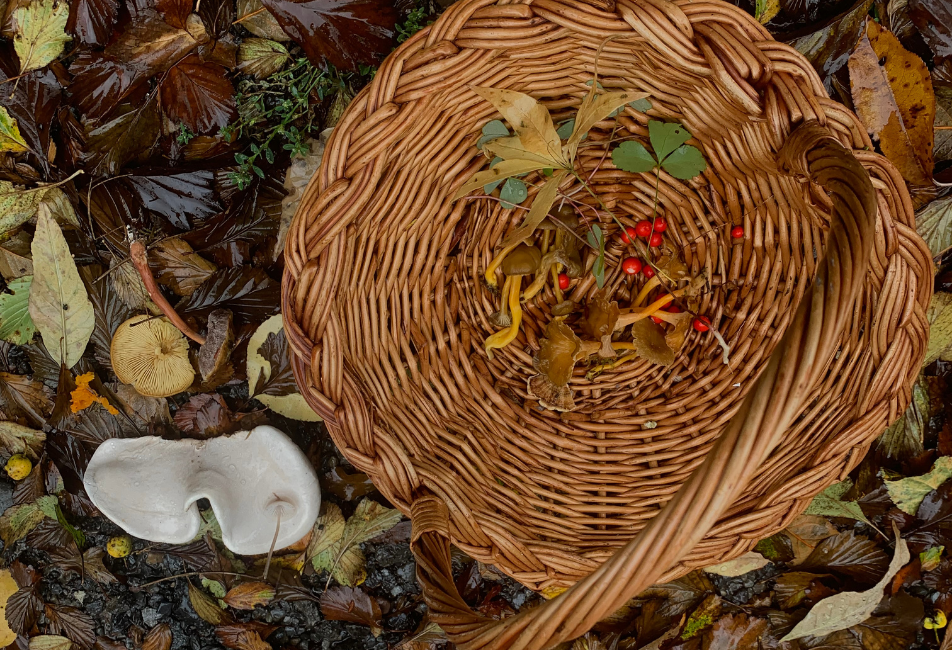
A cluster of mushrooms that popped up on a log in Nelson Swamp Unique Area in the rain. Mushrooms tend to grow especially well when it’s moist, so we foraged during a slight drizzle. It’s best to use a basket while mushroom foraging so the mushroom spores can disperse through the basket as you walk. Photos by Vivian Whitney.
Forgeable landscapes also provide nutrients and vitamins lacking in the diets of most consumers. We don’t typically get enough of certain vitamins like vitamin A and vitamin D through food we get at the grocery store, but Diemont explains these vitamins are commonly found in many forgeable plants. “Rosehips are very high in vitamins and unused typically. What if rose hips were a part of our local food system? What if rosehip jelly was made for the local schools?” Diemont suggests. “It wouldn’t provide a lot, but it would provide something.”
Rahma Edible Food Forest Snack Garden in Southside Syracuse is a small food forest that provides what it can in food and snacks at any hour. “There’s no fences or anything that keep anybody out,” says Frank Cetera, founder of Alchemical Nursery. Chatting with me on Zoom in a dress shirt and headset, Cetera is slender with a salt-and-pepper beard, ruddy complexion, and an easy smile. It’s hard to believe at first that he’s almost primarily responsible for tending to the quaint, disheveled garden that grows on a neighborhood block between the Rahma Health Clinic and a Conoco on South Salina Street.
Walking around the garden in early April, there wasn’t much greenery or many snacks to be had. Amid litter and cardboard boxes, a few daffodils peaked up through the winter’s remnants and fallen, rotting crab apples. But further into the spring and come autumn, the forageable garden will fill in with seasonal foods, some native to the area such as apples, pears, gooseberries, and currant, as well as lesser-known edible plants such as medlar, sunchoke tubers, plantain greens, and dock.
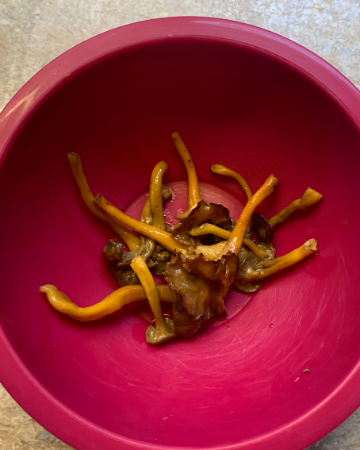
VanderStouw told me to sauté my handful of chanterelles with a bit of butter and salt, which I did as soon as I got home. Photo by Vivian Whitney.
“It’s supposed to be a snack garden so that people could go in there and get a snack of fruit instead of going to the corner store and buying some sugary, packaged, wrapped, processed food items from there,” Cetera says. Even ground cover plants at Rahma such as mint, which serves to protect the soil from erosion and drought, can freshen your breath and offer a lift to a drink as you’re passing by, he says.
While it’s difficult to gauge how often people forage in the garden, Cetera notes a rise in volunteers and people wanting to get involved at other community spaces and gardens managed by Alchemical Nursery. But despite how often people use the snack garden, it takes constant management to keep the space maintained and productive. “You can’t expect people to come out and volunteer at community gardens with all their time,” Cetera says. “But can we find a way to provide them with some sort of payment, some sort of stipend, or some sort of funds to reimburse them for their time?”
Even with volunteers and the garden’s 24/7 accessibility, much of the edible plants and fruits go unharvested. One thing food forests and foraging in general could offer besides food, though, is financial opportunities. At an Alchemical Nursery garden in Westside Syracuse, Cetera says the nursery will pay garden volunteers with money the nursery will make after selling peppers from the garden to a hot sauce company.
Until we live in a society where everyone’s basic needs are met, “urban farming and urban gardening as a business, I guess you would say, more so than just a hobby, is something to really take into true consideration,” Cetera says. Though access to food is an important basic need, there are other basic needs that food and food forests can’t address. “We have a fully capitalist system,” he says. “We need to have ways for people to put money in their pocket so that they can then transfer that to other needs.”
Especially given the array of societal problems the pandemic laid bare, others echo Cetera’s concerns. “That we’re controlling ecosystems to that extent and breeding plants to that extent when so much of the landscape is edible, it just doesn’t make sense,” Diemont says. “We need to be thinking differently about what a food system is.”
Although it’s unlikely in our current food system that self-sufficient food practices will ever provide the majority of our food, there is hope that foraging and gardening could become a bigger part of the general culture in the United States.
Yakovleva says in Russia, “It’s just a much more normalized part of daily life.” Even growing up in Moscow, where people didn’t have much access to wild, forgeable landscapes, wild foods and seasonal rituals centered around them were celebrated and continued. “After winter, you’ll see birch juice, which is just birch sap that’s not boiled down to a syrup, on everyone’s tables as kind of a celebration of making it to the next spring,” Yakovleva says. “If you go into a pharmacy, any normal pharmacy, like the equivalent of CVS, you’ll see shelves of dried herbs.”
In the U.S., this could mean making Diemont’s idea of foraged rosehip jelly in schools a reality. People don’t need to completely change their diet and eating patterns to incorporate more foragable foods into their meals. “There are hundreds of other plants we can be teaching people to use and lots of invasive plants that have really great culinary and food purposes that we’re not using,” Beebe says. One thing she pointed out that’s important to consider when incorporating foraged foods is that it takes work to add them to our diets. We need to think beyond “just eating dandelion salads that are not tasty,” she says. “Realistically, it’s not how people ate in a sort of pre-industrialized food system. But these plants were used in collaboration with other types of foods and procurement.”
While it was easy enough for me to forage some dandelion greens for dinner last month, the bitter taste of my sauteed dandelion greens and dandelion pesto even after semi-haphazard preparation made them a little hard to swallow. If a bigger foraging culture existed in mainstream America, maybe I would have learned from my mom how to properly blanch the greens. Maybe she could have sent me out into the field behind our house to pick dandelions and their greens for dinner and tea.
To change our production system to include more of the forgeable plants, Diemont says we need to focus on working on a group level, not as individuals. “I don’t know if you’ve tried some of the things that are forgeable, but they’re not all tasty,” he says. “So, we need to be working with chefs to actually help us figure out how to make things tasty.”
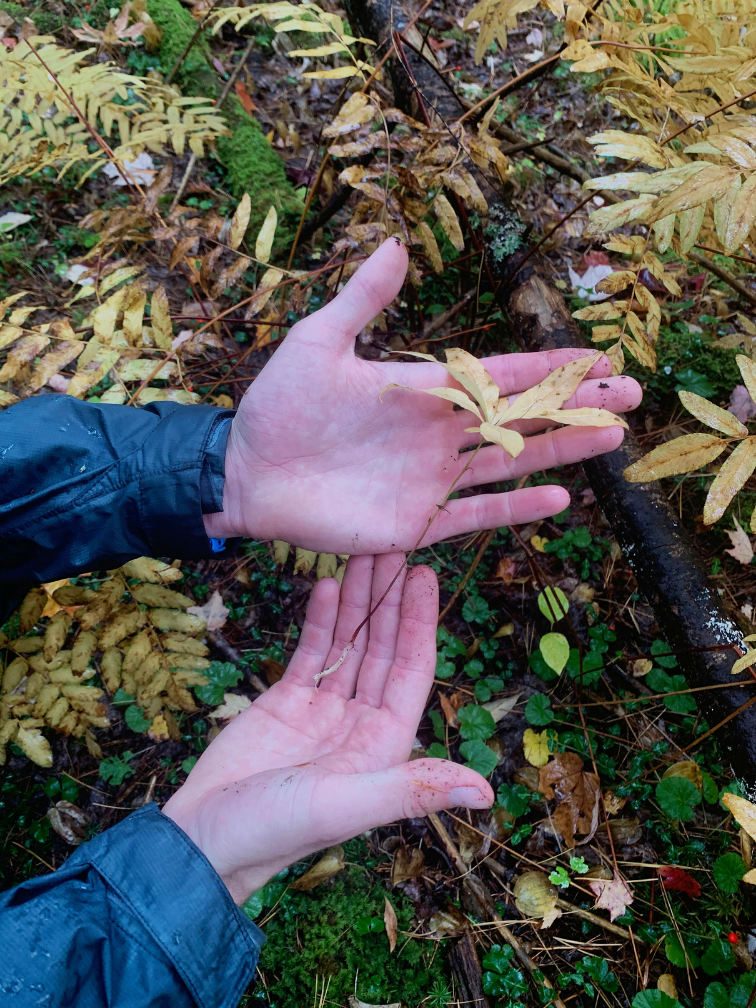
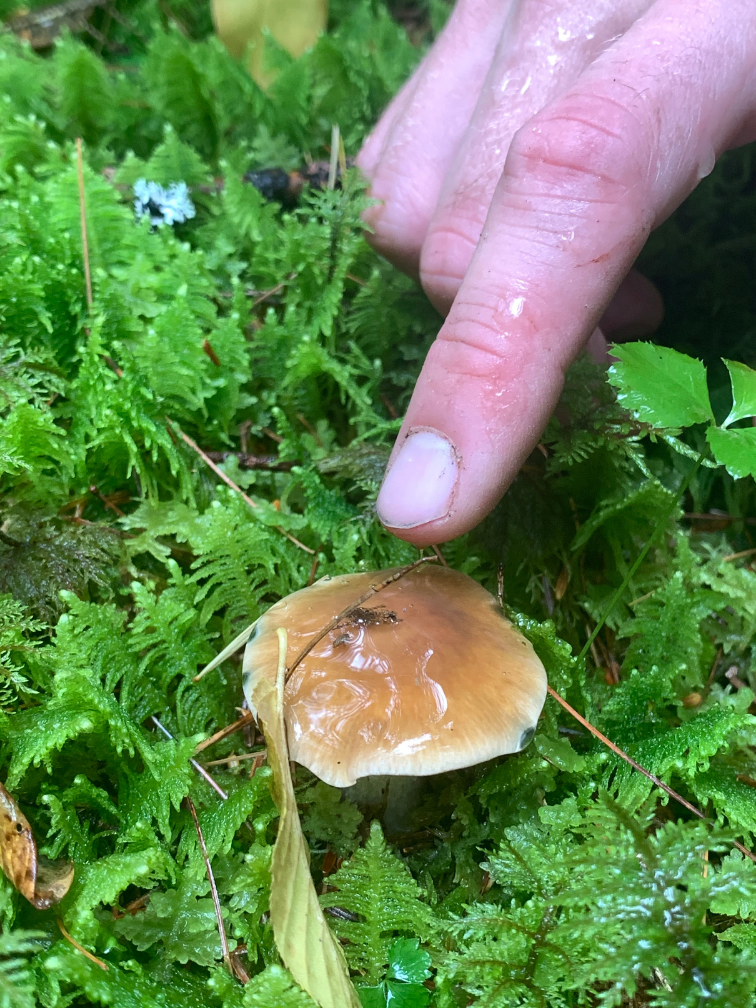
VanderStouw shows me an Indian cucumber-root. I tasted the bottom white root of the plant, which had a fresh, crisp taste. Though unsure of the type, VanderStouw notices this mushroom that he recognizes as having a slimy film on its top and shows me how it sticks to his finger when he touches it. Photos by Vivian Whitney.
This too would help build needed trust in forgeable foods. One barrier that keeps many from venturing out to find edible plants on their own is the fear of eating something toxic. In Russia, Yakovleva says “There’s less fear about possibility of misidentifying a plant or mushroom and it hurting you. I would say it’s less exoticized in that way.” Incorporating foraged foods more into the food system in the U.S. would help de-exoticize them and pass on trust to future generations.
“If a young person eats from the environment, they’re connected with that environment for a very long time. It’s like it creates an environmental ethic,” Diemont says. “I think that’s because you’re showing immense trust in the environment because when you walk up and you pick something, you’re saying, ‘I trust you.’” That trust creates a cycle, Diemont explains, that builds a deeper connection with the environment and our desire to care for and nurture it.
It took curiosity to pick unidentified mushrooms from my yard last March and trust to saute and enjoy a bowl of chanterelles I foraged in a swamp. But it took commitment and connection to dig in the mud and move ramps 20 miles to an inner-city park, cradling them in leaves and helping to establish a food forest. After returning home from Elmwood Park that day, I planned a celebratory ramp dinner for a group of friends to cook together. Piled into a cramped, college-house kitchen, the eight of us scrambled to pull together a four-course meal. I assigned everyone tasks, explaining the name of the leaves every few minutes as people forgot that they’re called ramps.
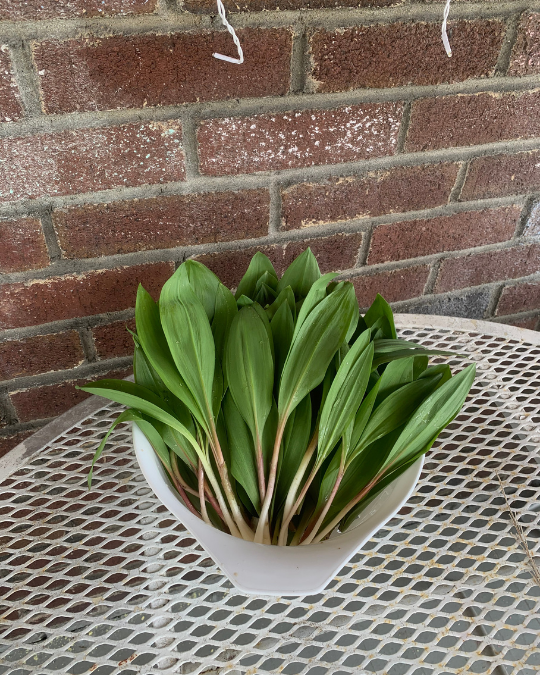
After a hectic hour and a half of preparation and cooking, my friends and I sat down to our spread showcasing Chahine and my foraged ramps. Photo by Vivian Whitney.
We sat down in our mismatched set of chairs with a family-style array of offerings, some of us with bowls to make up for the lack of eight plates. Ramp compound butter with crostini, caesar salad, mussels in a ramp and garlic white wine sauce, spaghetti with ramps — quite literally farm-to-table.
“We should go back next weekend to the spot and do this again next weekend,” Chahine joked. As I continued to remind my friends of the name of our foraged goods, everyone asked about how I’d gotten the ramps and what I was doing out in the woods. As I shared what I’d learned foraging, our conversation shifted to the bigger implications of our flawed food system, jumping from food deserts to labor in the food system and industrial agriculture’s impact on the environment. Seeing my friends’ interest in such important topics, sparked only by a handful of unfamiliar leaves, reminded me of the uninformed interest I first had when I saw those mushrooms in my yard last spring. Soon, they were stumbling over each other’s words trying to explain the importance of ramps to other roommates and guests passing through the dining room, the same way I now do to others when I see an edible plant growing in the wild. 
Our pursuit of outdoor joy is remiss without the acknowledgement of the occupation of unceded Indigenous land. We are students and journalists working, writing, and living on the land of the Haudenosaunee Confederacy, comprising the Six Nations made up of the Mohawk, Onondaga, Oneida, Cayuga, Seneca, and Tuscarora nations. However, acknowledgement is not enough. Read More.